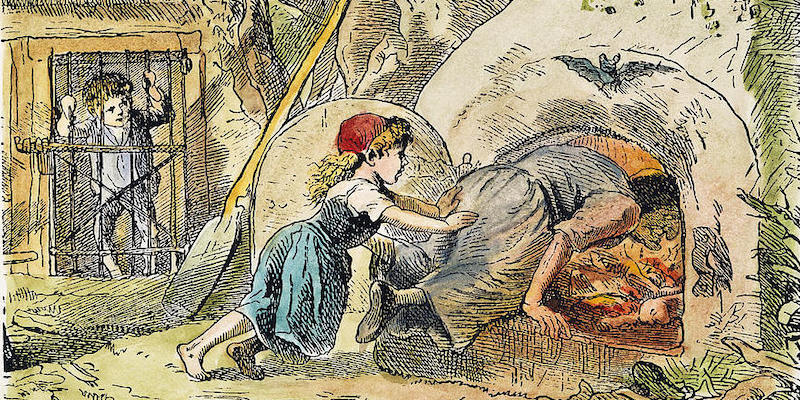Bad things happen in fairy tales. To good people. To bad people. To dragons and witches and princesses and bastard children. Usually they end with a happily ever after—the guy gets the girl or the girl gets revenge, the kingdom awakens, the peasants aren’t eaten but can go on with their miserable peasant lives—but to get that happy ending, a crime must be committed first. Epic betrayals, such as adultery and infanticide, but minor crimes too. Trespassing and petty theft and disorderly conduct. And then there are the exotic ones, the cases of bestiality and necrophilia and the like.
Modern crime fiction has nothing on the ingenuity, brutality and sheer bizarreness of the offenses committed in classic fairy tales. Moreover, fairy tales are ruthless. Our contemporary crime novels have the monopoly on moral ambiguity, true, but fairy tales take no prisoners and often offer no redemption. Mercy is not a hallmark of the genre and even the kindest, most benevolent maid-turned-princess isn’t afraid to take out her wicked stepmother.
Strip away the fairy godmothers and the helpful goblins, the magic trees and the singing bones, and you’re left with an array of hardboiled crimes straight out of Chandler or Highsmith, Christie or Connelly, and everyone in-between. Here are a few of my favorites, from fairy tales across the globe.
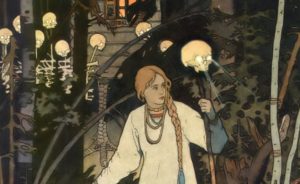
“Daughter Kills Family with Flaming Skull, Gets No Jail Time”
I’ve recently discovered Slavic folk and fairy tales and have become obsessed with the stories of Baba Yaga. One of the most popular is the tale of Vasilisa the Beautiful. In true fairy tale fashion, Vasilisa is gorgeous, industrious, and the bane of her stepmother’s and sister’s existence. They try to snuff her out by sending her to Baba Yaga, the witch in the woods, for a light. Vasilisa is so perfect, however, that Baba Yaga can’t stand her and instead of gobbling her up, sends her back home with a skull full of fire. When Vasilisa hands over the light her stepmother requested, it burns her alive. And her stepsisters. And destroys the house as well. Vasilisa, though, like Daenerys Targaryen emerging with her dragons, comes through unscathed and eventually snags a king for a husband.

“Lost Children Murder Old Woman by Baking Her Alive”
This would be, of course, the tale of Hansel and Gretel from the Brothers Grimm collection. This story has everything—an evil stepmother, forced marching, greedy kids lost in the woods, an edible house, and a not-so-bright witch who meets her demise in the end. Women often get a bad rap when it comes to fairy tales; they’re thought of as passive, prizes to be won, and sometimes they are. But unmarried girls, however, have a surprising amount of agency. They survive by their wits, and Hansel and Gretel is a perfect example of the cunning of girls in fairy tales. While Hansel is kept in a pen, fattening up for the witch’s supper, Gretel manages to trick the witch into getting inside her own oven, where she is promptly burnt to a crisp. Gretel saves the day and gets a candy house to boot.
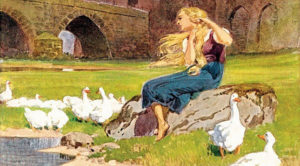
“Princess Cheated of Husband Uses Dead Horse to Get Revenge on Rival”
It would be tough to pick a favorite Grimm’s fairy tale, considering there are over two hundred to choose from, but if you held my feet to the fire, I’d have to choose The Goose Girl. It’s both morbid and terrifyingly strange, and definitely not suited for children. Self-mutilation, prophesizing drops of blood, decapitated horses and medieval forms of torture are rife from start to finish. It’s a meandering tale, but in essence it follows the trials of a princess who is forced by her chambermaid to switch places with her on the way to her wedding. The king is deceived and the true princess winds up herding geese and talking to the mounted head of her dead horse who, incidentally, talks back and eventually spills the beans on the chambermaid’s gold-digging scheme. The king then tricks his false bride into choosing her own punishment—being stripped naked, shoved in a barrel studded with nails and rolled down a hill—as the real princess takes her rightful place and becomes queen of all the realm. If that’s not a tabloid story fit for a crime novel, I don’t what is.
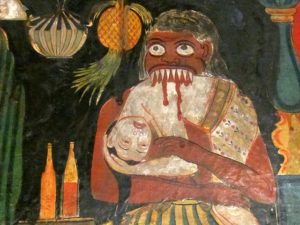
“Gambling Addict Participates in Child-Kidnapping Ring with Terrifying Giant”
In Nepalese legend, Gurumapa is a hideous, fanged giant who collects children who have disobeyed their parents. In the story of Kesh Chandra, we have an old man who is cast out of his sister’s house after he can’t stop gambling, going so far as to steal her flatware to sell and feed his habit. He wanders Kathmandu for a while until some pigeons take pity on him and turn their own shit into gold. Being messy birds, there is a lot of gold and Kesh, being a greedy man, had to have it all. He persuades Gurumapa, a fierce, man-eating giant who just happens to be wandering around nearby, to carry all the gold for him by promising to throw him a feast. Kesh Chandra also tells the giant that he has permission to kidnap any disobedient children in the area. Our gambling addict is taken in by Gurumapa and allowed to live in the giant’s attic, so long as he placates the village parents when the children stop coming home from school. It’s a match made in heaven and the two get on splendidly—Kesh enjoying his gold and gambling and Gurumapa enjoying his children.
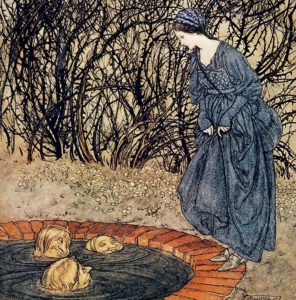
“Mother Commits Suicide after Stepdaughter is Blessed by Talking Heads, Disappointed in Offspring”
Death by suicide is the only real crime in the bizarre tale of The Three Heads of the Well, but in our current area of overly-ambitious stage parents, I think it’s both apt and deliciously strange. As expected, you’ve got a king, a stepmother, a stepdaughter and, of course, a mother-less daughter who goes out into the world to seek her fortune away from her bratty new family. An old man she is kind to repays the favor by telling her to visit a well where three heads—yep—are hanging out, waiting for someone to wash them and comb their hair. Upon doing so, they grant her the gifts of being beautiful, having a wonderful voice and becoming a queen. When she leaves the well she just so happens to run into a king who is charmed by her beauty and her voice and immediately marries her. Now, the stepmother, upon hearing this, sends out her own daughter, determined that she should make an even better match. This girl, however, is rude to the old man and the three heads and they blight her with leprosy, a terrible voice and a marriage to a mere cobbler. The jealous stepmother, however, is so mortified by her daughter’s humble marriage that she goes insane and eventually hangs herself. The story ends with the king celebrating the death of his wife and the ugliness of his stepdaughter. Yikes.
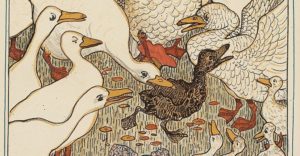
“Man Steals Duck, Sprouts Feather, Turns Masochist”
This strange tale hails from China and, while short, hinges on a simple crime. In Theft of a Duck, a man does just that—steals a duck from a farmer. The following morning, he wakes to discover that he has grown feathers all over his body in the night. They itch terribly but the next night the thief dreams that he will be granted relief if he returns to the farmer and the farmer calls him what he is, “a dirty thief.” The next day the thief goes to the farmer and tries to trick him into calling a neighbor a dirty thief, so the words will be spoken. The trick fails, as the farmer refuses to be so mean. Finally, desperate, the thief rips open his shirt to display his feathers and begs the farmer to call him a dirty thief. The farmer, being a good man, takes pity on the thief and berates him until his feathers disappear.

“Pathological Liar Betrays Father, Becomes Victim of Human Trafficking and is Falsely Presumed Dead”
Pinocchio. I’m not sure which Disney film was more disturbing to me as child—Pinocchio or Dumbo. I think I’ve blocked much of the Disney version out, but in reading the original serialized novel as an adult, I’ve realized just how disturbing this Italian fairy tale actually is. We all know the basics from the cartoon: the wooden puppet, his kind father, the blue fairy and Jiminy Cricket, wishing upon a star. But then you’ve got Pinocchio compulsively telling lies, killing his helpful cricket-sprit-guide, running away from home, being tricked and trapped into a grotesque puppet show on a ‘pleasure island,’ being swallowed by a whale, discovering his whale-swallowed father, dying and then being brought back to life as a human boy. And that’s the Disney version! In the original, Pinocchio is even more of a jackass (reference intended) than he is in the film. Our cruel puppet not only lies, cheats and swindles, but mutilates animals, physically abuses Geppeto, and is an all-around jerk, even as everyone continues to give him second chances. Pinocchio is the ultimate conman—faking his death, playing up his ‘puppet angle’ to gain sympathy and indulging in every possible vice from drinking to gambling to ogling other puppets. In short, Pinocchio is a hotbed of crimes and sin. Especially as, in the end, Pinocchio gets away with it all.
***
And then you’ve got Snow White (rape), Rapunzel (false imprisonment), Briar Rose/Sleeping Beauty (breaking and entering), Fitcher’s Bird/Bluebeard (serial killing), Little Red Cap/Red Riding Hood (animal abuse), The Robber Bridegroom, (cannibalism) and The Juniper Tree (child abuse)—and that’s just circling back around to the Grimm Brothers. Crime writers, if you ever need inspiration for a plot, you need look no further than the fairy tales we all grew up on. All the crimes you could ever want are there—right up to the happily ever after.

